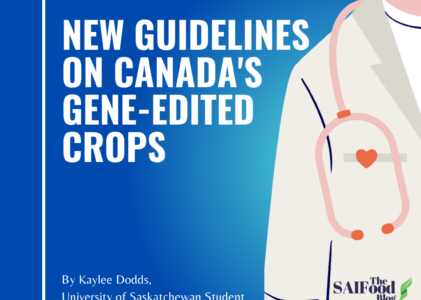Kaylee Dodds
University of Saskatchewan Student Guest Blogger
A year ago, on March 23, 2021, Health Canada proposed new guidelines for the regulation of gene-edited crops, indicating they are safe for human consumption and the environment (Health Canada 2021). This proposal comes after Health Canada completed their assessment on gene-edited crops to develop new guidelines around novel foods. They also stated that gene-edited crops are as safe as traditional plant breeding. Plant breeding innovation is the future of our food. However, the public is unsure about new technologies involved in their food system. They often look to regulations to trust that their food is safe. We need to continue to modernize plant breeding regulation, with only 39% of surveyed Canadians in 2021 thinking the food system is headed in the right direction in 2021, (CCFI 2021).
What does this mean?
Health Canada is revising existing regulations to better include gene-edited crops and other plant breeding innovations. The Federal agency of Health Canada plays an important role in ensuring the food we eat in Canada is safe. Changes to the Novel Foods regulation of the Food and Drug Act are only made after lengthy assessments. A novel food is any “new or changed [food product] compared to existing foods”. In the past 20 years, Health Canada has assessed over 140 novel foods derived from products of plant breeding and found all of them safe for human consumption (Health Canada 2021). Having a national regulatory body helps Canadians know about the health and safety of their food supply.
After assessing characteristics of gene-edited crops many times, Health Canada has found that gene-edited crops “do not pose a food safety concern” (Health Canada 2021). Health Canada continues to maintain a product-based system. A product-based system is assessing the product that ends up on our dinner plates, meaning that they focus on assessing the product from plant breeding rather than just the tools used to get there.
What is gene-editing and traditional plant breeding?
Plant breeders have used a large variety of techniques to improve plants for decades. Gene-editing is just one of the many tools plant breeders use. It uses technology to adjust a plant’s existing genes. Instead of waiting for the desired result to appear after generations of traditional plant breeding, plant breeders can choose when it happens through gene-editing. This makes gene-editing more efficient. Gene-editing can be used in genetically modified organisms (GMOs) but is referred to as its category of plant breeding. We are only able to edit genes after spending decades learning about DNA. Gene editing is a way to leverage this knowledge.
Why are these new guidelines important?
It is important to update guidelines for food to match current plant breeding practices like gene-editing. Plant breeders need to be able to have the tools to apply their knowledge. Farmers need access to improved crops. Consumers want more sustainable food. Gene-editing is one of the tools to achieve this.
These new guidelines are an important improvement but there is still a long way to go to improving farmers’ access to tools and modernizing plant breeding regulation. As gene-edited crops in the US are treated like conventional crops and largely don’t face additional regulation (Arnason, 2021). These updated guidelines will also help signal to the public that gene-editing is safe. Canadians need to know that the federal government has thoroughly assessed, and approved gene-edited crops.
I want Canadian farmers to have all the tools in their toolbox, to compete with international markets and to continue to produce sustainable food. I am proud of the work of Canada’s agriculture industry and I want them to continue to be innovative.
Arnason, R., 2021. “Gene Edited Crops Are Safe: Health Canada.” The Western Producer, 26 Mar. 2021, https://www.producer.com/news/gene-edited-crops-are-safe-health-canada/.
CCFI, 2019. “Helping Canad A’s Food System Earn Trust.” The Canadian Centre for Food Integrity, https://www.foodintegrity.ca/wp-content/uploads/2019/04/2018-Annual-Report-English.pdf.
Gov’t of Canada, 2021. “Summary: Proposed New Guidance for the Novel Foods Regulation, Focused on Plant Breeding – Canada.ca.” Canada.ca, Government of Canada / Gouvernement Du Canada, 23 Mar. 2021, https://www.canada.ca/en/health-canada/programs/consultation-guidance-novel-foods-regulation-plant-breeding/summary-proposed-guidance-plant-breeding.html.
Kaylee Dodds
Hello! I am Kaylee Dodds, a 4th-year Agribusiness student at the University of Saskatchewan. I was born and raised on a sheep farm near Lumsden, Saskatchewan. Last summer I worked for the Government of Saskatchewan Ministry of Agriculture in the Public Trust Unit. I have also had the opportunity to work for Agriculture and Agri-Food Canada in the Market and Industry Services Branch. Through these experiences, I have developed an interest in agricultural policy. I enjoy giving farm tours and teaching others about agriculture. I am excited to see where my future in agriculture leads.




way to go girl
It’s a really good read. Hopefully other countries also have stringent regulations in place to ensure production health and safety. Way to go!
Great article Kaylee!